TRN White Tiger
Does the White Tiger roar or does it purr?
The TRN White Tiger enters an incredible competitive IEM space with a hybrid dual DD + Planar and offering three tuning nozzles that allow users to tailor the sound to their preferences.
It has a very attractive mid-range price point of $69.99 and as you will see brings some attributes of much more expensive IEM offering into an attractive package, but it’s not without its strange quirks.

So, even in the past few weeks the number of planar IEM’s releases seems relentless, so does the TRN tiger have enough to stand out and ‘roar’ at the competition?
Note: I would like to thank Shenzenaudio for providing the TRN White Tiger for the purposes of this review.
It currently retails for an $69.99. Check out more details on Shenzenaudio via this non-affliated link: TRN White Tiger
Read on to find out.
Retail Box and Unboxing
The TRN White Tiger offers a premium unboxing experience. With a well-designed box and
excellent accessories:

On the back of the box:

Removing the outside sleeve reveals a nice box:

Opening this box reveals a very tough looking carrying box for the IEM and
2 boxes with accessories:

Taking everything out:

You get a reasonable selection of eartips and I do like that you get
both a 4.4mm and a 3.5mm adapter in the one box:

The cable is good quality but does tangle quiet easily, it is also extremely long for an IEM cable
and as you will see has some other quirks:

Though I do like the adapter mechanism - this is the cable end:

And each adapter can be easily plugged in assuming you align the arrow with the white dot:

And is very secure once connected:
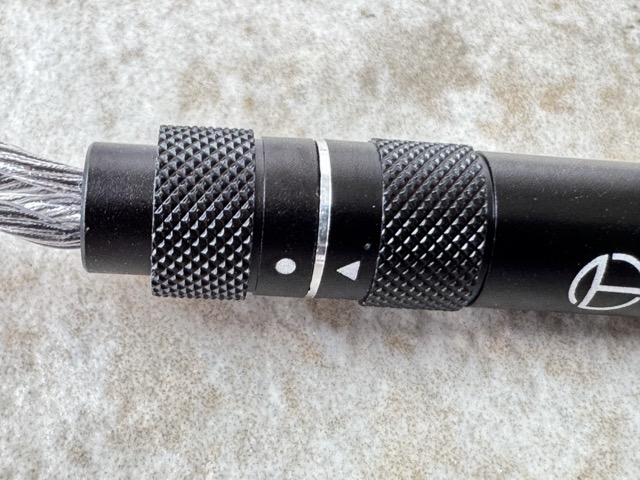
The storage box itself is extremely durable - I think a car could drive over this
box, and it would not break:

But do to the length of the cable, it is a tight fit for the IEMs and cable in the box:

Nozzles
One of the standout features is the inclusion of three tuning nozzles, allowing you to adjust
the sound signature from a tilted sound to more V-shaped sound as you will see in the measurements
section:

Note: 2 of them are much longer than the other one. More this when we get to the comfort and fix section.
The IEM Shell
The build of the TRN White Tiger is very solid, with its metallic shell giving it a premium feel.
I do really like the design of this shell:
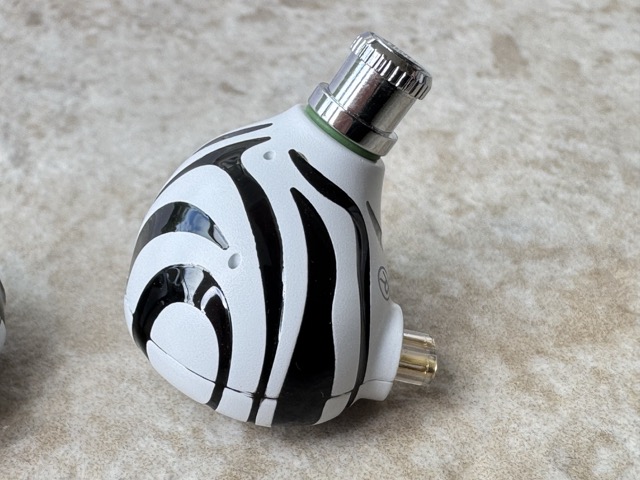

But you might notice in these pictures a few of my minor issues with
the White Tiger, so one is the 2-pin connection on the shell is not recessed
it actually sticks out:

But then the 2-pin connections on the cable is tiny:

At least a few times during my time with the white tiger the cable actually came
away from the shell in my ear:
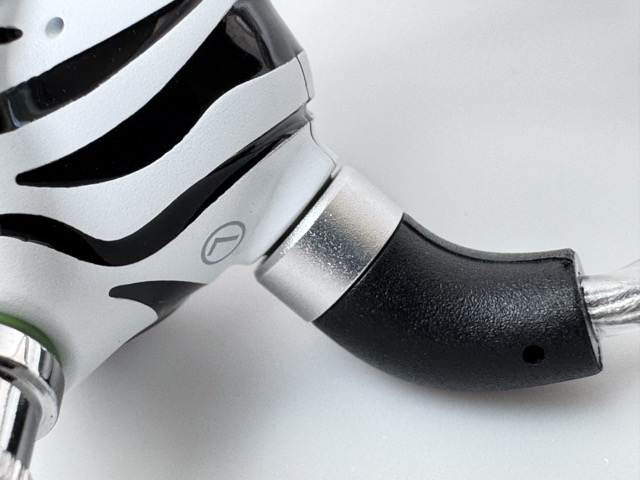
However, this wasn’t my main complaint, so I need to get onto the comfort and fix:
Comfort and Fit
So this will be very subjective and therefore do not take this as meaning it will be like
this for you, but I found the large nozzles would eventually cause me some discomfort though
part of this is I believe the angle of the nozzle compared to how the shell sits in my ear.
Its hard to describe, so I tried to capture some photos showing the angle of the nozzle on
a few of the other IEMs that also happen to have long nozzles (include the Truthear Zero
Red):
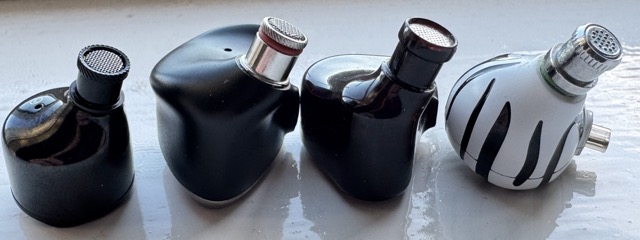

This photos probably shows the different angle of the White Tiger nozzle better:

But I think what made them uncomfortable was that believe they are long and not necessarily aligned with my ear canal, the IEM shell would pop out slightly with most of the stock ear tips. Considering I have no problem with the large nozzle on the Truthear Zero or with the even larger FiiO FH19 it has to be some combination of IEM shell shape and nozzle length.
Note: This was mainly when I used the White Tiger out on a walk so after maybe 10 minutes I would have to shove it back into my ear only for this to happen again a little later.
So, this is with two of the three nozzles as they are quite long. So if this happens to you definitely do some tip rolling and find one that is strong enough to keep the nozzle secure without being uncomfortable.
Driver Configuration
The White Tiger has an interesting configuration with the dual DD handling different frequencies. I would guess the 10.5mm handles the bass and the 8mm is handling the mid-range leaving the planar to handle the treble. TRN describe the planar as “6mm planar diaphragm, a thickness of only 2μm, and a hair-thin 0.01mm copper wire embedded in a lightweight composite diaphragm”.

Sound Impressions
These sound impressions with mainly from using the default ‘Green’ Nozzle, though I did experiment for a few hours with each nozzle:
Bass
The White Tiger’s bass is warm and full, with a strong mid-bass emphasis that adds weight to tracks without overwhelming them. It’s particularly well-suited to genres like hip-hop and EDM, providing a deep and satisfying rumble. I also really like some classic rock tracks from the 1970’s with “Led Zeppelin” “4 symbols” being a highlight. However, the bass does bleed slightly into the midrange, which can reduce clarity in more complex tracks.
A great example of the White Tiger’s bass prowess can be heard on Beyoncé’s “16 Carriages”—the thumping bass is impactful and energetic.
Midrange
The midrange is smooth and enjoyable, but the warmth from the bass can obscure some midrange details. Vocals come through clearly, but certain instruments and voice may feel a little unnatural, particularly in the upper mids.
This is noticeable on tracks like Bob Marley’s “Exodus”, where the midrange feels slightly restrained and overpowered, but it was still very engaging.
Treble
Treble on the White Tiger is well-controlled and I really appreciated what that planar is doing in the upper treble region. But the White Tiger also carefully avoids harshness, making it a comfortable listen for extended periods without fatigue.
Tracks like New Order’s “Fine Time” showcase the balanced treble response with well-articulated highs that complement the bass.
Soundstage and Imaging
The soundstage of the White Tiger is relatively narrow, with a more intimate presentation. It lacks the relative width of some competitors but still manages to offer decent midrange layering and separation. The imaging is good, but as I mentioned the mid-bass can occasionally congest the sound in busier tracks.
On Led Zeppelin’s “Whole Lotta Love”, the soundstage feels confined, but the swirling effects in the middle of the song are well-placed.
Specifications and Measurements
| Specification | Details |
|---|---|
| Transducer type | Hybrid in-ear monitors |
| Driver configuration | 10.5mm Dynamic Driver + 8mm Dynamic Driver + 6mm Planar Magnetic Driver |
| Frequency response | 20Hz-40000Hz |
| Impedance | 16Ω |
| Sensitivity | 118dB |
| Connector type | 2-Pin |
| Jack type | 3.5mm + 4.4mm |
| Weight | ~7.2g + 23g (Single Earphone + Cable) |
| Wear | Ear hook |
| Cable type | Four-strand silver-plated cable |
| Cable length | 1.2m±3cm |
Measurements
All my measurements are taken with my 711 clone coupler and are available here
First lets look at the frequency response:
Frequency Response

This is with the default green nozzle and shows good channel matching. You can see that warm mid-bass in this graph at least compared to the usual ‘Harman bass’ that typically separates bass from midrange in a Harman tuning.
But otherwise this is a solid tuning with great channel matching.
So lets look at the difference with the other nozzles:

So the black nozzle (the short one) gives the brightest tuning here with almost harman IE level of treble. The green and especially the red nozzle have that much more now popular recessed upper midrange similar to the “new meta” tuning. More on this in a bit.
Distortion
So the distortion is excellent, well below audible limits even playing at > 100dB:
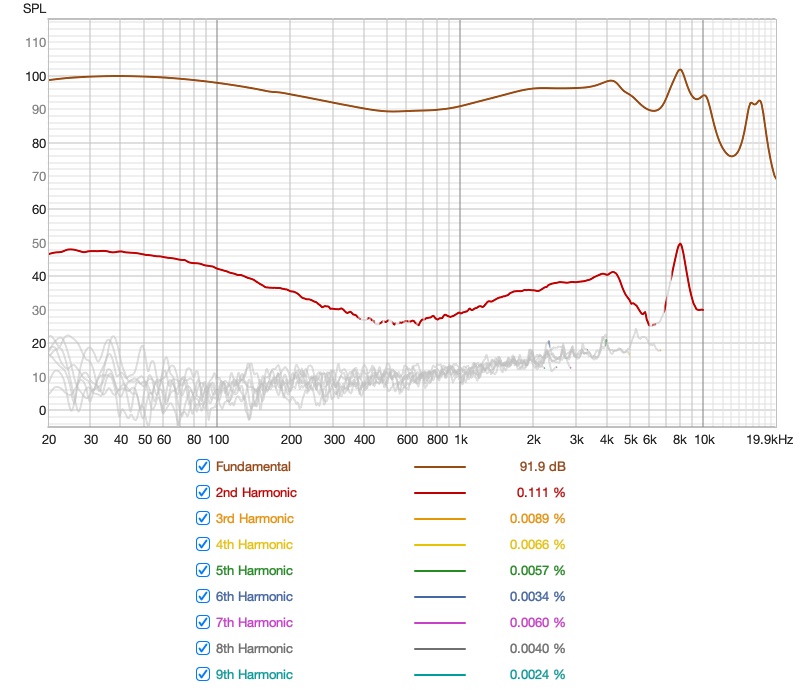
And shows as a percentage:

Comparisons:
So of the IEMs I have recently measured I thought I would select a few with similar
profiles, especially this tuning that had that “new meta” like recessed upper mid-range.
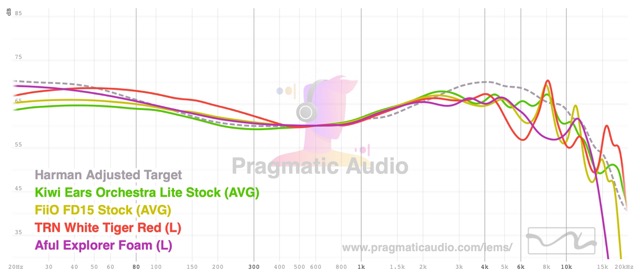
These other IEM’s though have different flavours of bass, with the Aful Explorer having a Harman like bass and with the Orchestra Lite being more ’neutral’ and the FiiO FD15 being in-between those variations. But again you can see that “warmth’ in the mid-bass of White Tiger. For me this makes the White Tiger an interesting alternative and a fun listen for certain genres of music, but it would not be my preference.
Rating
I give the TRN White Tiger a pragmatic rating of 4 stars. The accessories and tuning flexibility are standout features, but the fit and bass-midrange bleed can be a downside for some users.
Conclusion
The TRN White Tiger is a solid offering in the mid-tier IEM market. It delivers a warm and engaging sound signature, particularly for bass-heavy genres, but comes with some quirks with the comfort at least for me. But I do love how unique the shell looks:

And the tuning flexibility and excellent accessory package make it a good option for those looking to experiment with sound signatures especially in this price range and especially for those who what that planar sound.
Despite its quirks, it’s an IEM worth considering for those wanting a fun, flexible listening experience.